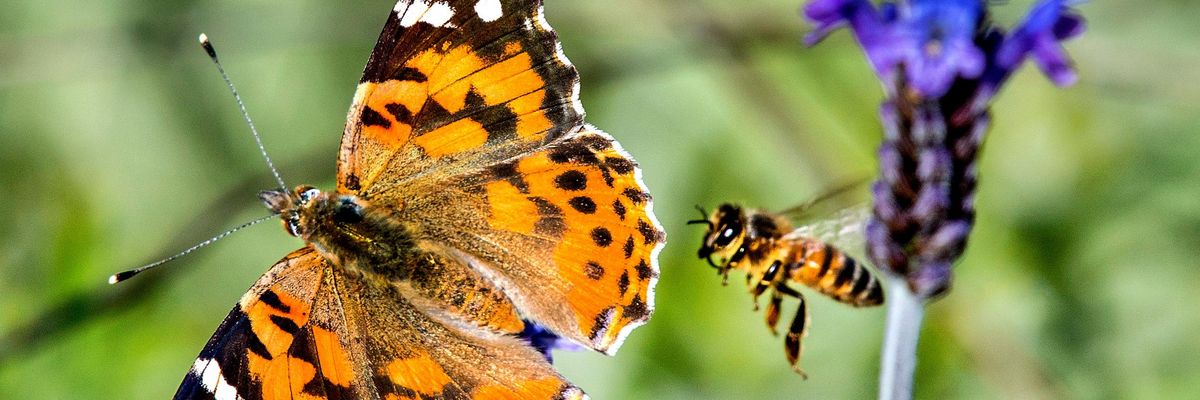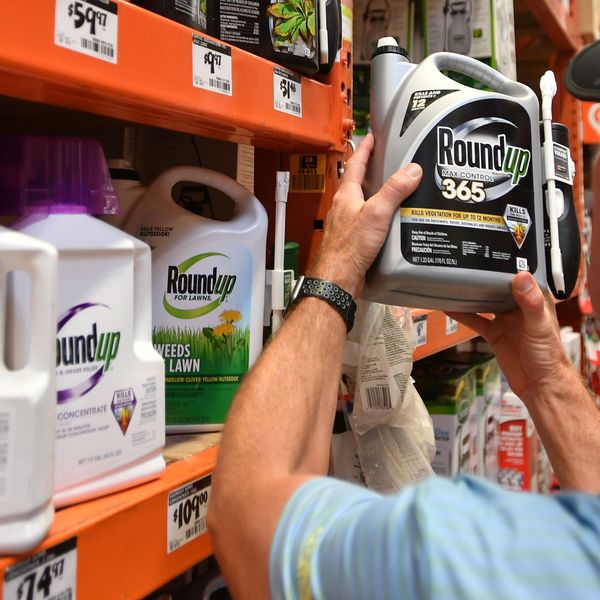
A honey bee approaches a painted lady butterfly perched on a flower in a North Tustin garden on Wednesday, March 13, 2019, as swarms of butterflies invade Southern California as a result of an unusually heavy migration making its way from Mexico to the Pacific Northwest to breed, experts say.
'Ban Neonicotinoids Right Now,' Say Conservationists After EPA Pesticide Review
"The EPA doesn't need any more proof," said one expert after agency analyses detailed threat to endangered species.
Environmental and food safety advocates highlighted Thursday the decline in iconic pollinators following new analyses released by the U.S. Environmental Protection Agency showing three widely used neonicotinoid insecticides are "likely to adversely affect" the majority of the endangered plants and animals the agency assessed.
"These extremely toxic pesticides are causing drastic ecological harm, both the collapse of bee populations as well as putting literally hundreds of endangered species at extinction risk across the country."
"Now the EPA can't ignore the fact that these popular insecticides are wiping out our country's most endangered plants and animals," Lori Ann Burd, environmental health director at the Center for Biological Diversity, said in a statement.
"Neonicotinoids are used so widely, and in such large quantities," she said, "that even the EPA's industry-friendly pesticide office had to conclude that few endangered species can escape their toxic effects."
Burd's comments came in response to draft biological evaluations for three neonicotinoids, or "neonics," which are: clothianidin, imidacloprid and thiamethoxam. The evaluations, which now face a 60-day public comment period, were required by settlements the agency reached earlier this year with NRDC and the Center for Food Safety (CFS).
Neonics have come under the repeated scrutiny of environmental watchdogs and scientists, with previous studies linking their use to harm to insects, including bees and butterflies, as well as birds and freshwater marine species.
In its Thursday statement, the Center for Biologicical Diversity summarized the EPA's damning findings on the neonics' adverse impacts to threatened species and their habitats :
Nearly 80% of all endangered species--1,445 different kinds of plants and animals--are likely to be "adversely affected" by imidacloprid, and the pesticide will adversely modify the designated critical habitats of 658 species. For thiamethoxam, 1,396 (77% of all) endangered species are likely to be adversely affected, and the pesticide will adversely modify the designated critical habitats of 644 species. About two thirds of all endangered species, 1,225, are likely to be adversely affected by clothianidin, and the pesticide will adversely modify the designated critical habitats of 644 species.
CFS also noted the "remarkable levels of harm" the evaluations found with regards to the neonics.
According to George Kimbrell, legal director of the group, the analyses "confirm what scientists have told EPA and industry for over a decade: These extremely toxic pesticides are causing drastic ecological harm, both the collapse of bee populations as well as putting literally hundreds of endangered species at extinction risk across the country."
In light of that confirmation, Kimbrell urged the Biden administration "to complete its process with all due speed in order to start protecting these iconic species."
Burd, in her comments, stressed that there's simply no reason for the EPA to further drag its feet on taking neonics off the shelves.
"The EPA doesn't need any more proof. It should ban neonicotinoids right now," she said, pointing to "a heartbreaking extinction crisis" in which neonics "are playing an outsized role."
"Pollinator populations are declining nationwide," Burd said, citing as evidence the decline in the American bumblebee. "Once the most common bumblebee in the country, [it] has declined by an estimated 89% in just the past 20 years. There are more Starbucks stores than monarch butterflies in California."
"What will it take," she asked, "for the EPA to act on this information and ban these deadly chemicals?"
An Urgent Message From Our Co-Founder
Dear Common Dreams reader, The U.S. is on a fast track to authoritarianism like nothing I've ever seen. Meanwhile, corporate news outlets are utterly capitulating to Trump, twisting their coverage to avoid drawing his ire while lining up to stuff cash in his pockets. That's why I believe that Common Dreams is doing the best and most consequential reporting that we've ever done. Our small but mighty team is a progressive reporting powerhouse, covering the news every day that the corporate media never will. Our mission has always been simple: To inform. To inspire. And to ignite change for the common good. Now here's the key piece that I want all our readers to understand: None of this would be possible without your financial support. That's not just some fundraising cliche. It's the absolute and literal truth. We don't accept corporate advertising and never will. We don't have a paywall because we don't think people should be blocked from critical news based on their ability to pay. Everything we do is funded by the donations of readers like you. Will you donate now to help power the nonprofit, independent reporting of Common Dreams? Thank you for being a vital member of our community. Together, we can keep independent journalism alive when it’s needed most. - Craig Brown, Co-founder |
Environmental and food safety advocates highlighted Thursday the decline in iconic pollinators following new analyses released by the U.S. Environmental Protection Agency showing three widely used neonicotinoid insecticides are "likely to adversely affect" the majority of the endangered plants and animals the agency assessed.
"These extremely toxic pesticides are causing drastic ecological harm, both the collapse of bee populations as well as putting literally hundreds of endangered species at extinction risk across the country."
"Now the EPA can't ignore the fact that these popular insecticides are wiping out our country's most endangered plants and animals," Lori Ann Burd, environmental health director at the Center for Biological Diversity, said in a statement.
"Neonicotinoids are used so widely, and in such large quantities," she said, "that even the EPA's industry-friendly pesticide office had to conclude that few endangered species can escape their toxic effects."
Burd's comments came in response to draft biological evaluations for three neonicotinoids, or "neonics," which are: clothianidin, imidacloprid and thiamethoxam. The evaluations, which now face a 60-day public comment period, were required by settlements the agency reached earlier this year with NRDC and the Center for Food Safety (CFS).
Neonics have come under the repeated scrutiny of environmental watchdogs and scientists, with previous studies linking their use to harm to insects, including bees and butterflies, as well as birds and freshwater marine species.
In its Thursday statement, the Center for Biologicical Diversity summarized the EPA's damning findings on the neonics' adverse impacts to threatened species and their habitats :
Nearly 80% of all endangered species--1,445 different kinds of plants and animals--are likely to be "adversely affected" by imidacloprid, and the pesticide will adversely modify the designated critical habitats of 658 species. For thiamethoxam, 1,396 (77% of all) endangered species are likely to be adversely affected, and the pesticide will adversely modify the designated critical habitats of 644 species. About two thirds of all endangered species, 1,225, are likely to be adversely affected by clothianidin, and the pesticide will adversely modify the designated critical habitats of 644 species.
CFS also noted the "remarkable levels of harm" the evaluations found with regards to the neonics.
According to George Kimbrell, legal director of the group, the analyses "confirm what scientists have told EPA and industry for over a decade: These extremely toxic pesticides are causing drastic ecological harm, both the collapse of bee populations as well as putting literally hundreds of endangered species at extinction risk across the country."
In light of that confirmation, Kimbrell urged the Biden administration "to complete its process with all due speed in order to start protecting these iconic species."
Burd, in her comments, stressed that there's simply no reason for the EPA to further drag its feet on taking neonics off the shelves.
"The EPA doesn't need any more proof. It should ban neonicotinoids right now," she said, pointing to "a heartbreaking extinction crisis" in which neonics "are playing an outsized role."
"Pollinator populations are declining nationwide," Burd said, citing as evidence the decline in the American bumblebee. "Once the most common bumblebee in the country, [it] has declined by an estimated 89% in just the past 20 years. There are more Starbucks stores than monarch butterflies in California."
"What will it take," she asked, "for the EPA to act on this information and ban these deadly chemicals?"
Environmental and food safety advocates highlighted Thursday the decline in iconic pollinators following new analyses released by the U.S. Environmental Protection Agency showing three widely used neonicotinoid insecticides are "likely to adversely affect" the majority of the endangered plants and animals the agency assessed.
"These extremely toxic pesticides are causing drastic ecological harm, both the collapse of bee populations as well as putting literally hundreds of endangered species at extinction risk across the country."
"Now the EPA can't ignore the fact that these popular insecticides are wiping out our country's most endangered plants and animals," Lori Ann Burd, environmental health director at the Center for Biological Diversity, said in a statement.
"Neonicotinoids are used so widely, and in such large quantities," she said, "that even the EPA's industry-friendly pesticide office had to conclude that few endangered species can escape their toxic effects."
Burd's comments came in response to draft biological evaluations for three neonicotinoids, or "neonics," which are: clothianidin, imidacloprid and thiamethoxam. The evaluations, which now face a 60-day public comment period, were required by settlements the agency reached earlier this year with NRDC and the Center for Food Safety (CFS).
Neonics have come under the repeated scrutiny of environmental watchdogs and scientists, with previous studies linking their use to harm to insects, including bees and butterflies, as well as birds and freshwater marine species.
In its Thursday statement, the Center for Biologicical Diversity summarized the EPA's damning findings on the neonics' adverse impacts to threatened species and their habitats :
Nearly 80% of all endangered species--1,445 different kinds of plants and animals--are likely to be "adversely affected" by imidacloprid, and the pesticide will adversely modify the designated critical habitats of 658 species. For thiamethoxam, 1,396 (77% of all) endangered species are likely to be adversely affected, and the pesticide will adversely modify the designated critical habitats of 644 species. About two thirds of all endangered species, 1,225, are likely to be adversely affected by clothianidin, and the pesticide will adversely modify the designated critical habitats of 644 species.
CFS also noted the "remarkable levels of harm" the evaluations found with regards to the neonics.
According to George Kimbrell, legal director of the group, the analyses "confirm what scientists have told EPA and industry for over a decade: These extremely toxic pesticides are causing drastic ecological harm, both the collapse of bee populations as well as putting literally hundreds of endangered species at extinction risk across the country."
In light of that confirmation, Kimbrell urged the Biden administration "to complete its process with all due speed in order to start protecting these iconic species."
Burd, in her comments, stressed that there's simply no reason for the EPA to further drag its feet on taking neonics off the shelves.
"The EPA doesn't need any more proof. It should ban neonicotinoids right now," she said, pointing to "a heartbreaking extinction crisis" in which neonics "are playing an outsized role."
"Pollinator populations are declining nationwide," Burd said, citing as evidence the decline in the American bumblebee. "Once the most common bumblebee in the country, [it] has declined by an estimated 89% in just the past 20 years. There are more Starbucks stores than monarch butterflies in California."
"What will it take," she asked, "for the EPA to act on this information and ban these deadly chemicals?"

